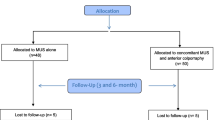Abstract
Cystocele repair can lead to de novo stress urinary incontinence (SUI) or exacerbate pre-existing SUI. This study was designed to determine the effect of cystocele repair by transobturator mesh on SUI. In a retrospective observational study, we saw 93 patients after a transobturator mesh procedure. Of those, 57 women had not undergone a concomitant anti-incontinence procedure. We analyzed their clinical data and ultrasound datasets. At a median follow-up of 9 months, 21 of 24 preoperatively stress incontinent women reported cure/improvement, one patient reported worsened SUI. Seven of 33 preoperatively continent women complained of de novo SUI. There is a net positive effect on SUI (McNemar χ2 exact test p = 0.013) after transobturator mesh. A narrower gap between symphysis pubis and mesh was associated with a positive outcome (p = 0.015 on ANOVA). Transobturator mesh for cystocele repair appears to have a net positive effect on SUI.

Similar content being viewed by others
References
Roovers J-PWR, Oelke M (2007) Clinical relevance of urodynamic investigation tests prior to surgical correction of genital prolapse: a literature review. Int Urogynecol J 18:455–460
Bai SW, Jeon MJ, Kim JY, Chung KA, Kim SK, Park KH (2002) Relationship between stress urinary incontinence and pelvic organ prolapse. Int Urogynecol J 13:256–260
Chaikin DC, Groutz A, Blavas JG (2000) Predicting the need for anti-incontinence surgery in continent women undergoing repair of severe urogenital prolapse. J Urol 163(2):531–534
Borstad E, Kulseng-Hanssen S, Moghimi K, Sandved M, Majida M, Western K et al (2006) An incontinence procedure performed at the time of prolapse repair might be unnecessary surgery. Neurourol Urodyn 25:551–552
Adekanmi OA, Freeman RM, Puckett M, Jackson S (2005) Cystoceles: does anterior repair fail because we fail to correct the fascial defects? A clinical and radiological study. Int Urogynecol J 16(S2):S73
Seeger D, Schmidt A, Kimming R (2006) Transobturator polypropylene mesh interposition for paravaginal defect repair in women with symptomatic cystocele POP-Q stage III/IV—a prospective trial. Int Urogynecol J 17(S2):S268
Shek KL, Dietz HP, Rane A, Balakrishnan S (2008) Transobturator mesh repair for large and recurrent cystocele. Ultrasound Obstet Gynecol 32:82–86
Tunn R, Picot A, Marschke J, Gauruder-Burmester A (2007) Sono-morphological evaluation of polypropylene mesh implants after vaginal mesh repair in women with cystocele or rectocele. Ultrasound Obstet Gynecol 29:449–452
Bump RC, Mattiasson A, Bo K, Brubaker LP, DeLancey JO, Klarskov P et al (1996) The standardization of terminology of female pelvic organ prolapse and pelvic floor dysfunction. Am J Obstet Gynecol 175:10–17
Dietz HP (2004) Ultrasound imaging of the pelvic floor: 3D aspects. Ultrasound Obstet Gynecol 23:615–625
Dietz HP, Shek C, Clarke B (2005) Biometry of the pubovisceral muscle and levator hiatus by three-dimensional pelvic floor ultrasound. Ultrasound Obstet Gynecol 25:580–585
Dietz HP (2004) Ultrasound imaging of the pelvic floor. Part I: two-dimensional aspects. Ultrasound Obstet Gynecol 23:80–92
Balakrishnan S, Lim Y, Barry C, Corstiaans A, Rane A (2006) First prospective long term study of the perigee transobturator cystocele repair system. Int Urogynecol J 17(S2):S274
Lombroni J, Ubertazzi E, Sarsotti C, Soderini H, Altuna S, Perez Junqueira S (2006) Anterior prolapse repair using perigee:preliminary report of the Argentinean multicenter experience. Int Urogynecol J 17(S2):S270
Ammendrup A, Bendixen A, Sander P, Lose G (2006) Urinary incontinence surgery in Denmark from 2001–2003. Int Urogynecol J 17(S2):S110
Feifer A, Corcos J (2007) The use of synthetic sub-urethral slings in the treatment of female stress urinary incontinence. Int Urogynecol J 18(9):1087–1095
Dietz HP (2004) The ‘iris effect’: how two dimensional and three-dimensional ultrasound can help us understand anti-incontinence procedures. Ultrasound Obstet Gynecol 23:267–271
Abdel-fattah M, Ramsay I, on behalf of the West Scotland Study Group (2008) Retrospective study of the new minimally invasive mesh repair devices for pelvic organ prolapse. BJOG 111:22–30
Shek KL, Rane A, Goh J, Dietz HP (2008) Perigee versus Anterior Prolift in the treatment of cystocele. Int Urogynecol J 19(S1):S88
Acknowledgements
This work was part-funded by the Betty Byrne Henderson Foundation, Brisbane, Queensland, Australia. We thank Adrienne Kirby, Biostatistician, Sydney West Area Health Service, for help with the statistical analysis.
Conflicts of interest
A. Rane has received honoraria from AMS for training other surgeons. H.P. Dietz has acted as a consultant for AMS.
Author information
Authors and Affiliations
Corresponding author
Rights and permissions
About this article
Cite this article
Shek, K.L., Rane, A., Goh, J. et al. Stress urinary incontinence after transobturator mesh for cystocele repair. Int Urogynecol J 20, 421–425 (2009). https://doi.org/10.1007/s00192-008-0789-2
Received:
Accepted:
Published:
Issue Date:
DOI: https://doi.org/10.1007/s00192-008-0789-2




